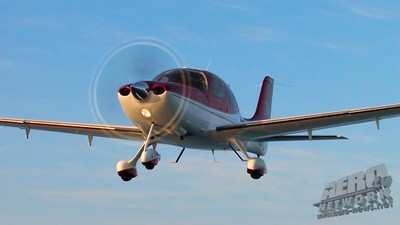Aircraft Was Enroute To Indianapolis When Pilot Became
Incapacitated
 The NTSB has released its preliminary report on an accident
that occurred when the pilot of a Cirrus SR22 became incapacitated
on a flight from York, Nebraska to Indianapolis, Indiana. The plane
eventually exhausted its fuel, and went down in a wooded area near
Ravenswood, West Virginia.
The NTSB has released its preliminary report on an accident
that occurred when the pilot of a Cirrus SR22 became incapacitated
on a flight from York, Nebraska to Indianapolis, Indiana. The plane
eventually exhausted its fuel, and went down in a wooded area near
Ravenswood, West Virginia.
NTSB Identification: ERA09FA429
14 CFR Part 91: General Aviation
Accident occurred Thursday, July 30, 2009 in Ravenswood, WV
Aircraft: CIRRUS SR-22, registration: N581DS
Injuries: 1 Fatal.
This is preliminary information, subject to change, and may
contain errors. Any errors in this report will be corrected when
the final report has been completed.
On July 30, 2009, at 2149 EDT, a Cirrus SR-22, N581DS, was
destroyed when it impacted terrain in Ravenswood, West Virginia.
The certificated airline transport pilot, the sole occupant,
sustained fatal injuries. Instrument meteorological conditions
prevailed, and an instrument flight rules flight plan was filed for
the Title 14 Code of Federal Regulations Part 91, personal flight.
The flight originated from York Municipal Airport (JYR), York,
Nebraska, about 1840, and according to the flight plan, was bound
for Eagle Creek Airpark (EYE), Indianapolis, Indiana.
According to the non-pilot owner of the airplane, he and the
accident pilot completed the flight from EYE to JYR at 25,000 feet
while breathing supplemental oxygen from the on-board oxygen
system. The pilot then departed on the return flight to EYE. The
oxygen system was not serviced prior to departure, but was going to
be serviced at EYE "on Monday."
According to preliminary information from the FAA, and data
downloaded from the Recoverable Data Module (RDM), the flight was
incrementally cleared by ATC to climb to 25,000 feet. At 1857, the
flight was cleared to climb from 22,000 feet and to maintain 23,000
feet. The pilot acknowledged the instruction, but the controller
noted that his voice had changed, and had taken on a "helium/Mickey
Mouse" quality.
At 1905, the pilot announced that he was climbing to 26,000
feet. ATC had cleared the pilot to 25,000 feet and noted that the
pilot was "stepping all over himself." Later, the pilot was given a
vector to avoid traffic, which the pilot acknowledged, but when
instructed to proceed on course, the pilot's response was
"unreadable." At 1925, the pilot requested a descent to 12,000
feet, and "sounds in distress and out of breath."
The flight was first cleared to descend to 24,000 feet, which
the pilot acknowledged, and then at 1927, the pilot was instructed
to descend to 12,000 feet and was issued the altimeter setting. The
pilot acknowledged the call and repeated the altimeter setting.
However, the airplane maintained cruise flight at 25,000 feet.
ATC attempted to contact the pilot for approximately 6 minutes
before the pilot responded with, "Go ahead." The airplane was again
issued a clearance down to 12,000 feet and instructed to "begin
your descent." An airline pilot on the frequency commented that the
accident pilot sounded "incoherent." The last radio transmission
received from the airplane, at 1937, was the "pilot's labored
breathing." At 2051, the airplane crossed directly over EYE, at
25,000 feet, and maintained its on-course heading.

File Photo
The airplane continued in cruise flight at 25,000 feet until
2146, when engine power and fuel flow parameters dropped to zero,
and engine cylinder head and exhaust gas temperatures dropped
significantly. A brief simulation of flight instruments for the
final minutes of the flight showed the airplane increasing nose-up
pitch and decelerating at 25,000 feet until a sharp, descending
left spiral was entered. The instruments then depicted a random
string of spiraling left and right turns and 360-degree rotations
around the roll axis before the data stream was lost.
The Ohio Air National Guard launched F-16 Fighting Falcon jets
in pursuit of the accident airplane, but the Air Force pilots were
unable to gain the pilots attention visually or by radio. They
noted that the pilot appeared "unconscious" at the flight controls.
The Air Force jets remained with the airplane until it departed
controlled flight, and descended into terrain.
A review of FAA records revealed that the pilot held an airline
transport pilot certificate with ratings for single engine and
multiengine land airplanes; flight instructor certificates for
airplane single engine, multiengine, and instrument airplane; and a
commercial pilot certificate for rotorcraft and single engine
seaplanes. Additionally, he held a Learjet type rating. The pilot
reported 18,500 hours of total flight experience on his most recent
application for a Federal Aviation Administration first-class
medical certificate, which was issued on July 14, 2009.
The pilot's logbook was not immediately recovered, but a review
of an insurance renewal form dated July 23, 2009 revealed that the
pilot reported 18,700 total hours of flight experience, 500 hours
of which were in make and model.
The Recoverable Data Module (RDM) and components from the
airplane's supplemental oxygen system were retained for examination
at the National Transportation Safety Board (NTSB) materials and
flight recorders laboratories.
 ANN's Daily Aero-Linx (04.13.24)
ANN's Daily Aero-Linx (04.13.24) ANN's Daily Aero-Term (04.13.24): Beyond Visual Line Of Sight (BVLOS)
ANN's Daily Aero-Term (04.13.24): Beyond Visual Line Of Sight (BVLOS) Airborne 04.09.24: SnF24!, Piper-DeltaHawk!, Fisher Update, Junkers
Airborne 04.09.24: SnF24!, Piper-DeltaHawk!, Fisher Update, Junkers Aero-News: Quote of the Day (04.14.24)
Aero-News: Quote of the Day (04.14.24) ANN's Daily Aero-Term (04.14.24): Maximum Authorized Altitude
ANN's Daily Aero-Term (04.14.24): Maximum Authorized Altitude




